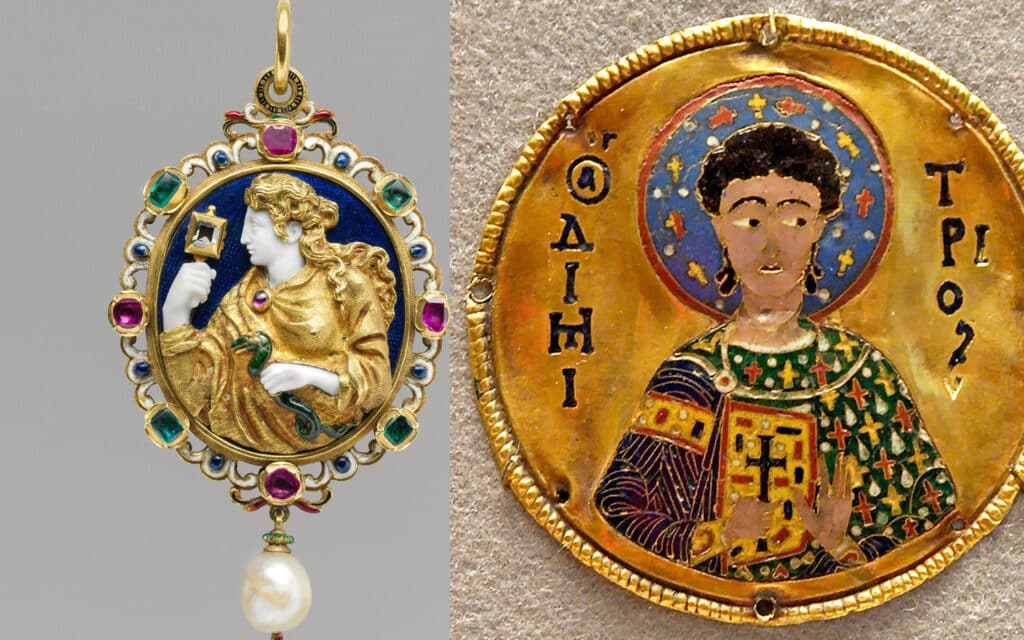

Enamelling is basically the art of fusing glass particles (vitreous enamel grains) on metal under high temperature. Enamellists usually use silver, gold, copper and low carbon steel for enamelling, among others. Enamelling is an art that is like a miracle! We are applying some powders over metal that after exposing the piece to high temperature (using kiln or torch), will give us high-quality glass surface. This art is called vitreous enamel or hot enamel to differentiate it from resin works or industrial enamels.
We- enamel lovers- enjoy even looking at high-quality enameled pieces. Look at a brilliant shiny cloisonné piece with various transparent shades and depth of colours. Enamel paints are beautifully firing and never fade or change the colours. Even in terms of durability, the oldest enamel was made in around the 13th century B.C. The above picture shows two old glorious enamel pieces. The enamel on the left side is a Byzantine medallion from the frame of an icon with St. Gabriel, housed in the Djumati Monastery (circa 110) and the enamel jewelry on the right side of the picture is a Pendant with figure of Prudence, from second half 16th century, housed in the Metropolitan Museum of Art. The features and colours of enamel pieces do not change during time. So the only threat is to drop them on hard surface that might break them.
From the viewpoint of an enamellist, enamelling can be very difficult and unpredictable and on the other hand, full of joy and innovation. Enamelling is a very big world, full of possibilities for an artist who loves creation.
Enamel grains can basically be combination of silica, soda ash and potassium nitrate that are mixed according to specific formulae*. Each enamel colour has its own formulae and some extra raw materials. Some warm colours have gold in their composition.
Enamel grains have various sizes that are measured by mesh size. Mesh size is defined based on the number of holes per linear inch in a mesh screen. The mesh size you are choosing for enamelling directly depends on the project and techniques you want to use. For example for cloisonné, 60 or 80 mesh size enamels are suitable. On the other hand, for painting, you need finer grains.
Enamels are coming in various colours and shades. They can be opaque, transparent or translucent. Also, depending on the temperature that is perfect for their fusing, they are categorized to soft-, medium- or hard-fusing enamels. Soft-fusing enamels should be fired at lower temperatures and/or shorter times. It is important that when you are firing several enamels together on a piece of metal , they have close fusing temperatures. Otherwise, you will over- or under-fire some of them while some have fused perfectly.
They are lots of enamelling methods. Some of main methods are cloisonné, champlevé, plique a jour and enamel pint. Champlevé is a technique that enamel is being inlaid into depressions of metal. These depressions are usually produced using etching, chasing or engraving. Cloisonné is a popular technique that after firing flux on metal, very thin metal stripes are fused on flux and then enamel is inlaid between the stripes. The stripes or cloisonné wires are actually the lines of the painting or the pattern. In plique a jour, after cutting some designs on metal, the holes are filled with enamel. The beauty of this technique is that light will pass through enamel.
Nowadays, modern enamellists use lots of techniques and we are not limited to ancient techniques, any more. I am interested in exploring these modern techniques in particular. And hopefully, I will write about them in the future.
*The art of enameling by Linda Darty, page 9, first paperback edition, 2006
Links to the pictures of enamels:
https://en.wikipedia.org/wiki/File:Medallion_St_Demetrios_Louvre_OA6457.jpg
We use cookies to improve your experience on our site. By using our site, you consent to cookies.
Manage your cookie preferences below:
Essential cookies enable basic functions and are necessary for the proper function of the website.
These cookies are needed for adding comments on this website.
Stripe is a payment processing platform that enables businesses to accept online payments securely and efficiently.
Service URL: stripe.com (opens in a new window)
Statistics cookies collect information anonymously. This information helps us understand how visitors use our website.
Google Analytics is a powerful tool that tracks and analyzes website traffic for informed marketing decisions.
Service URL: policies.google.com (opens in a new window)
You can find more information in our Privacy Policy.